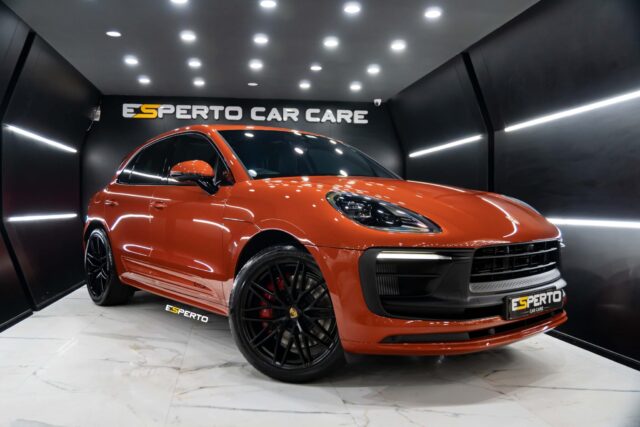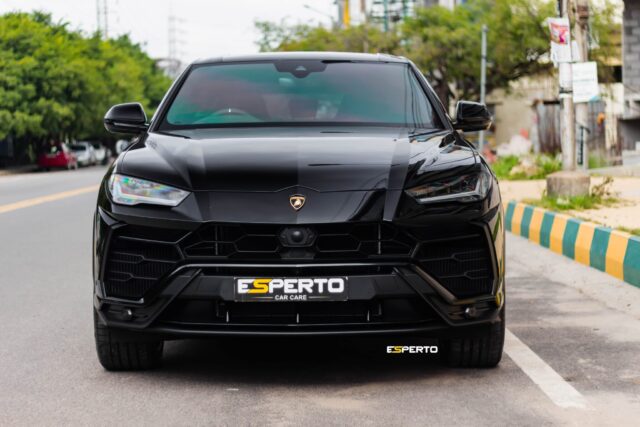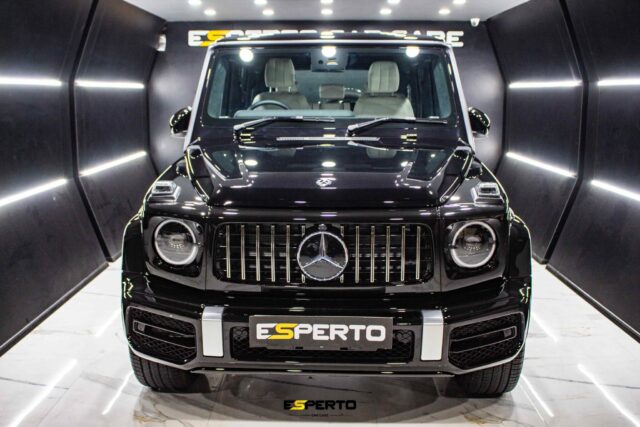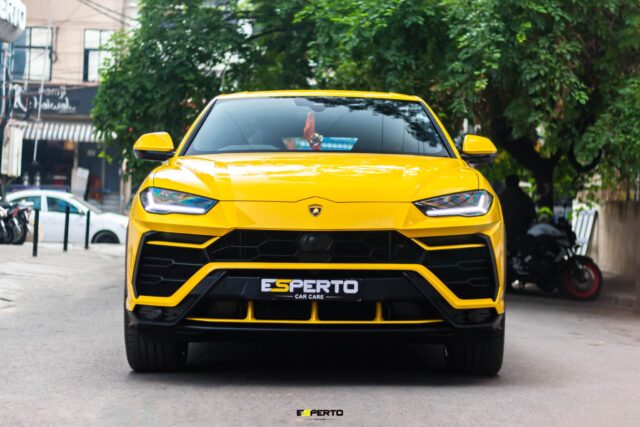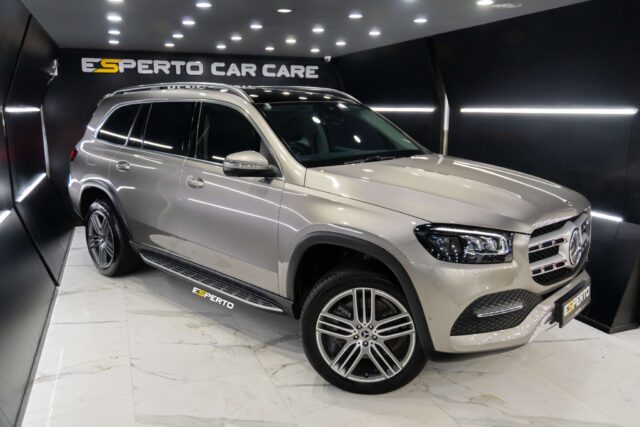What is the Purpose of Car Wrapping? Benefits and Insights Explained
Many car owners wonder about the purpose of car wrapping. They want to know if it’s right for their vehicles. What is the purpose of car wrapping? Car wrapping involves covering your car with a vinyl film, giving it a new look without the need for a complete paint job.
One interesting fact is that a wrap can protect the original paint underneath from scratches and UV damage. This article will explain how car wraps work, their benefits, and why they might be the best choice for refreshing your car’s appearance.
Keep reading to find out more!
What is a Car Wrap, and How Does it Work?
Moving from the general topic of vehicle maintenance, we’ll concentrate on a targeted approach that benefits and elevates a vehicle’s look: vehicle wrapping. Vehicle wrapping involves covering your complete car or a few parts with vast vinyl stickers.
This method provides an opportunity to update your car’s appearance without shelling out for a costly paint job. Vinyl wraps are available in various finishes like matte, gloss, metallic, and others, making them fit for unique designs.
Vehicle wraps function by putting a vinyl layer right on top of the car’s original paint. Experts utilize heating devices to stretch the vinyl, shaping it to the vehicle’s structure.
This results in a sleek surface that mimics paint but offers the convenience of easy removal or alteration. Wrapping not only facilitates drastic color alterations but also serves as a protective layer against potential scratches and defenses against UV damage to the original paint.
Understanding the Basics of Vehicle Wrap
Vehicle wrap involves covering your car, bike, or fleet with a layer of vinyl. This process can either cover the entire vehicle or just parts of it for style, marketing, or protection reasons.
The vinyl used in wraps comes in various designs and finishes, such as matte, gloss, and even custom graphics. Wrapping your vehicle allows you to change its appearance without needing a potentially expensive paint spray.
Applying a wrap is detailed work that starts with cleaning the vehicle thoroughly. A professional then stages the car wrapping and carefully sticks the vinyl coating onto the car’s surface. They use a heat gun to shape the material around curves and edges for a smooth finish.
This method offers an efficient way to refresh your car’s appearance or display your business’s logo and contact details on the side of your vehicle.
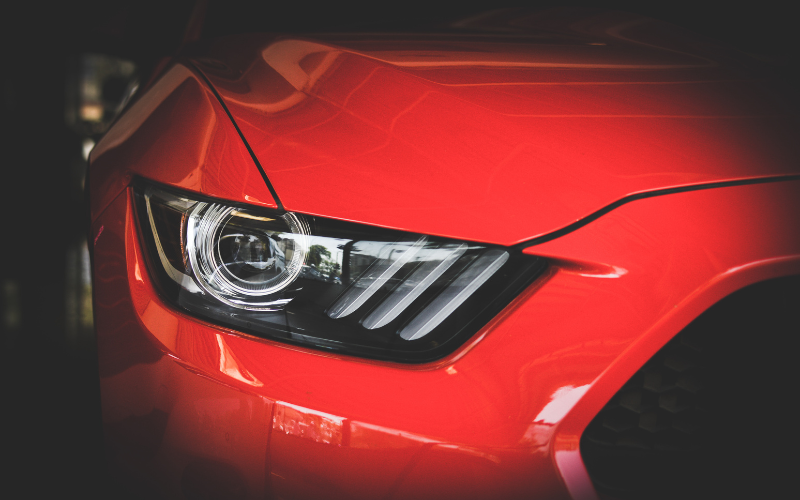
How Does a Vinyl Wrap Compare to a Paint Job?
Car owners, car enthusiasts, and bike lovers often debate the merits of vinyl wraps versus traditional paint jobs. Understanding the differences can help you make an informed decision about which option is best for your vehicle.
| Aspect | Vinyl Wrap | Paint Job |
|---|---|---|
| Cost | Generally less expensive than a high-quality paint job. | Typically more costly, especially for premium finishes. |
| Installation Time | Takes a few days to complete. | Can take weeks, considering drying and curing times. |
| Durability | Lasts about 5 to 7 years with proper care. | Can last 10 years or more, depending on quality and maintenance. |
| Protection | Offers additional protection against scratches, UV rays, and minor abrasions. | Provides durable surface protection but may need more maintenance to prevent fading. |
| Customization | Allows for extensive customization with various designs, patterns, and colors. | Limited to colors and requires more effort for intricate designs. |
| Resale Value | Preserves the original paint, potentially improving resale value. | May increase value if done professionally, but custom colors could deter some buyers. |
| Reversibility | Easily removed to return to the original paint finish. | Permanent change to vehicle’s appearance. |
Choosing between a vinyl wrap and a paint job depends on your budget, the level of customization you desire, and how you use your vehicle. Wraps offer a versatile, cost-effective way to change your car’s look while protecting its original paint. In contrast, paint jobs provide a permanent, classic finish with depth and shine that can last for years. Both options have their place in automotive care, appealing to different needs and preferences.
What Does a Wrapped Car Look Like Paint?
A wrapped car can easily be mistaken for a painted vehicle at first glance. The advanced materials and techniques used in wrapping ensure that the vinyl coat mimics the look of traditional paint wrap color changes closely.
From a matte finish to a high-gloss shine, car wraps offer a range of appearances that rival new paint jobs. They can display the business’s logo, contact details, graphics, or any custom wrap designs with stunning clarity and durability.
The beauty of a vinyl wrap lies in its ability to change the appearance of your vehicle while also providing protection.
Unlike paint, which may chip or fade over time, a properly applied vinyl car wrap maintains its vibrancy and shields the car’s paint from light scratches, abrasions, UV rays, and minor damages caused by road debris.
Car enthusiasts appreciate how wraps update their vehicle’s look without compromising the underlying paint quality.
What are the Advantages of Car Wraps?
Car wraps offer several benefits, making them a popular choice among car owners and enthusiasts. They serve as a defense for your vehicle’s original paint from light scratches, chips, and the sun’s harmful UV rays.
This keeps the paintwork looking new and helps maintain the car’s value over time. Wrapping your entire car or just parts of it can result in a completely new look without the need for an expensive paint job.
A vinyl wrap proves cheaper and is less permanent than painting, allowing you to change designs or return to the original color with ease. Many vehicle owners also explore the combined benefits of car wrap and ceramic coating to enhance both protection and shine, making their vehicles more resilient against environmental factors.
One significant advantage is how wrapping a car can improve resale value. Since the original paint remains protected under the wrap, potential buyers will find the vehicle more appealing due to its pristine condition.
Car wraps also provide an opportunity for custom designs or advertising wraps that make your vehicle stand out or serve as mobile billboards for businesses. These versatile benefits show why choosing to wrap your car could be a wise decision.
Moving on, let’s explore how long these vinyl car wraps last and what influences their durability.
How Do Car Wraps Provide Paint Protection?
Car wraps act as a shield for your vehicle’s paint. They protect the original paintwork from light scratches, chips, and abrasions that can happen daily. Think of car paint protection treatments as a plastic vinyl layer covering your car entirely or partially.
This layer of plastic vinyl keeps harmful UV rays from fading the paint and defends against chemical contaminants that could damage the surface. With gentle washing, this protection lasts without degrading the wrap’s appearance.
Wraps also guard against minor damages caused by bird droppings or tree sap, which can damage or corrode the surface unprotected surfaces over time. Properly applied wraps ensure these hazards don’t directly contact your car’s paint, preserving its look and integrity for years to come.
Next, we’ll explore what benefits of car wraps should catch a car owner’s interest.
What Benefits of Car Wraps Should Car Owners Consider?
Car wrapping serves multiple purposes, ranging from aesthetic enhancements to protecting the vehicle’s paint. It involves entirely or partially covering your vehicle with a vinyl coating, offering both style and defense against elements.
- Paint protection treatments come in many forms, but car wraps stand out by providing a barrier against scratches, abrasions, and UV damage. This layer shields the original paint, preserving the car’s appearance and integrity.
- Changing your car’s look is straightforward with vinyl wraps. You can wrap your entire car for a paint wrap color change without the long-term commitment of a new paint job.
- Vehicle resale value benefits significantly from vinyl wrapping. A well-maintained wrap can improve the market value of your car by keeping the original paint in pristine condition.
- Car wraps offer customization options that are not possible with regular paint jobs. With various designs available, owners can use their cars as canvases to display unique graphics or advertise businesses.
- The durability of vinyl wraps is noteworthy; they can last up to seven years if properly taken care of. Factors like hand washing and parking away from direct sunlight help maintain the wrap’s appearance over time.
- Vinyl wraps act as a defense against minor damages, such as light scratches and chips that would otherwise directly affect your vehicle’s original paint.
- Removal of vinyl wraps reveals the preserved paint underneath, making it an attractive option for those leasing vehicles or planning to sell in the future.
- Compared to traditional painting methods, wrapping a car is more cost-effective in achieving a brand-new look or custom design without expensive full-paint services.
- Wraps also provide an additional layer of chemical topcoat protection against common pollutants like bird poo and tree sap, which can corrode or stain the vehicle’s surface.
- Maintenance becomes easier with vinyl wrapped cars since they require less traditional waxing; simple washing will keep them looking great.
Through these benefits, car owners can enjoy both aesthetic flexibility and essential protective measures for their vehicles without compromising on quality or value.
Can Wrapping a Car Improve Resale Value?
Coating a car can certainly augment its resale value. This is due to the protective layer it provides to the original paint against scratches, abrasions, and UV damage. An automobile with well-kept paintwork usually fetches a higher price than its counterparts with cosmetic defects or faded paint.
Also, the vinyl coating can be taken off, allowing the car to revert to its original color, which can be appealing for buyers who favor the original finish.
Car owners who opt for high-quality wraps gain from amplified protection and sustain their vehicle’s allure over an extended period. Excellent vinyl ensures that when they decide to sell, their automobile stands unique in a competitive market.
The subsequent step is to understand the longevity of these advantages and the elements that influence the durability of a car wrap.
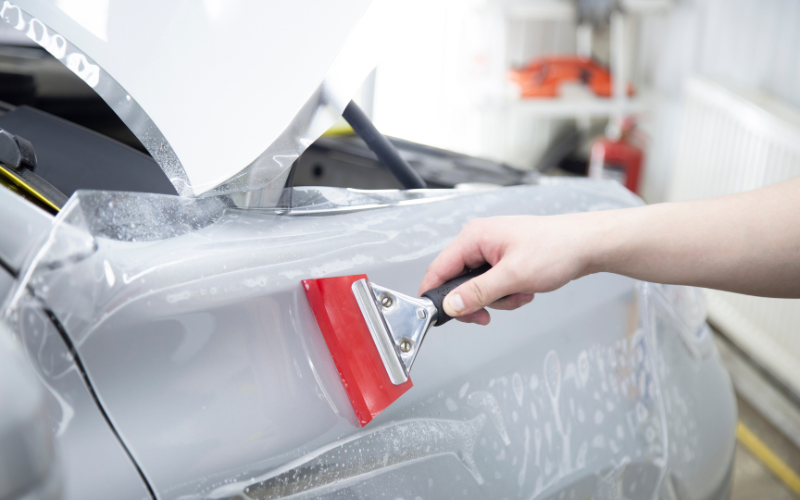
How Long Does a Vinyl Car Wrap Last?
A vinyl car wrap can protect your vehicle for about five to seven years, depending on several factors. These include how well you maintain the wrap and the conditions it faces daily.
Sun exposure, harsh weather, and frequent car washes can degrade the wrap faster.
To extend the life of your vinyl car wrap, experts suggest parking in shaded areas and hand washing your vehicle. Using high-quality vinyl for the wrapping protects my car, which also plays a crucial role in its longevity.
Proper care keeps the wrap looking great over time and helps maintain your car’s resale value.
What Factors Affect the Durability of a Wrap?
Car wraps give your vehicle a new look and offer protection. The durability of a wrap or paint protection can vary significantly due to several factors.
- Quality of wrap materials: High-quality vinyl wraps resist scratches, abrasions, and UV rays better than cheaper alternatives.
- Professional installation: A properly applied wrap avoids issues like bubbling or thin spots that look cheap and can wear out faster.
- Exposure to the elements: Sunlight, heavy rain, and pollutants can degrade a wrap over time.
- Frequency of washing: Regular cleaning with gentle soaps helps maintain the wrap’s appearance but using harsh chemicals or high-pressure washes can cause damage.
- Physical impacts: Scrapes from low branches or minor accidents can tear or puncture the vinyl.
- Care in maintenance: Using soft cloths and avoiding abrasive tools will keep the wrap from getting scratched up.
- Parking habits: Vehicles parked outdoors without cover are more prone to fading and peeling compared to those kept in garages.
- Bird droppings and tree sap: These contain acids that can erode the wrap if not cleaned off promptly.
Each of these factors plays a role in how long your car’s wrap looks great and functions as intended for paint protection treatments and enhancing resale value. Properly caring for your wrap extends its life, ensuring it doesn’t look bubbled, thin, or just thin, cheap, and ragged prematurely.
How to Keep Your Wrap Looking Great Over Time?
Maintaining the appearance of your vinyl car wrap ensures it continues to protect and enhance your vehicle’s looks. Proper care correctly so car wrapping prevents issues like colors fading, vinyl becoming bubbled thin, and dirt getting trapped underneath the surface.
- Wash your wrapped vehicle regularly. Dirt, bird droppings, and contaminants like tree sap can degrade the wrap over time. Hand washing every two weeks with mild soap and water helps keep it clean without damaging the vinyl.
- Use a gentle cloth or sponge for cleaning. Abrasive tools can scratch the wrap, making it look worn out.
- Avoid high-pressure washes directly on the edges. The intense pressure can cause the wrap to lift or peel, leading to moisture and dirt getting trapped.
- Apply a vinyl protectant after washing. Look for products designed for vehicle wraps to offer an extra layer of UV protection, which helps in preventing fading.
- Park your car in shaded areas when possible. Excessive sun exposure can cause the color of your vehicle to fade and warp over time due to UV radiation.
- Stay away from automatic car washes that use brushes. Their bristles can be too harsh on wraps, causing peeling or bubbling.
- Remove stains immediately using isopropyl alcohol diluted with water. Allowing stains to sit for too long may result in permanent discoloration.
- Keep your vehicle stored indoors or covered during extreme weather conditions like hailstorms, which could physically damage the wrap.
- Regularly inspect your wrap for signs of wear and tear, such as lifting edges or scratches and abrasions, addressing any issues quickly to avoid further damage.
- Lastly, consider re-wrapping parts that are severely damaged instead of trying extensive repairs which may not restore the original look of your vehicle.
Following these steps will help ensure that your car’s vinyl wrap maintains its vibrant color and protective properties, ultimately extending its lifespan while keeping your vehicle looking grand auto.
Is Car Wrapping Reversible?
Car wrapping is a reversible process, offering car owners the freedom to change their vehicle’s look without permanent alteration. Professionals can remove vinyl wraps carefully, ensuring that the vinyl coating is stuck and the paint underneath stays intact and unharmed.
This feature makes car wrapping an attractive option for those looking to protect the original color of their vehicle or fleet while enjoying a custom wrap that can display unique designs and contact details.
Removing a badly applied car wrapping requires skill to avoid leaving residue or damaging the paint. The correct removal technique involves gently heating the vinyl coating, making it easier to peel off from the surface without harm.
After removal, professionals usually perform a thorough clean-up to ensure no adhesive remnants could become trapped underneath future wraps, keeping your vehicle’s appearance looking tremendous and maintaining its value.
How simple is it to remove a vinyl wrap?
Removing a vinyl wrap can be straightforward if done correctly. Professionals use heat and special tools to carefully remove the wrap without harming the paint underneath. This process requires patience and careful attention to detail to ensure that no residue or adhesive remains on the surface.
Many car owners find this reversibility appealing, as it allows for easy updates or return to the vehicle’s original look.
The condition of the vehicle’s paint plays a crucial role in how easily a wrap can be removed. High-quality wraps tend to come off cleaner, mainly when they have been applied over paint in good condition.
Poorly prepared surfaces or low-grade materials might complicate removal, risking damage to the underlying paint. Proper technique ensures that wrapping acts as an effective defense as car paint against scratches, abrasions, and UV rays while being removable with care.
What Happens to the Paint Underneath?
Many worry that a vinyl wrap might damage the original paint on their vehicle. The truth is, if a professional properly prepares the surface before applying the car wrap, it can actually protect your paint.
Car wraps act as a shield against scratches, abrasions, and UV rays that can fade and wear down your car’s exterior over time.
Professional installation ensures that the vinyl coating sticks correctly to the car without trapping air bubbles or dirt, which could harm the paint underneath. If ever you decide to remove or change your wrap, doing so correctly means your original paint remains intact and preserved just as it was before wrapping.
This leaves your car’s looks unharmed by bad installations or cheap materials and preserves its value.
Next, let’s explore how choosing the right type of vehicle wrap design can transform your vehicle’s aesthetics. For more tips and insights on car care, check out articles related to handy car maintenance practices, such as hand wash methods that help keep your vehicle in top condition.
How to Choose the Right Wrap for Your Vehicle?
Choosing an ideal car wrap involves thinking about multiple critical factors to guarantee a top-notch car wrap application. First, assess the range of vehicle wrap designs on offer.
This variety lets you modify your car’s aesthetic to match your style and preferences. Whether it’s displaying business details and graphics or choosing full paint-like finishes, there’s a design that meets every requirement.
Next, concentrate on making sure experts properly prepare the surface of your car’s surface correctly before applying the vinyl coating. An appropriately prepared surface is critical as it avoids typical problems such as the wrap appearing bubbly, thin, or inferior post-installation.
Opt for cheap services or materials recognized for their carefulness and high-quality materials to bypass issues like scratches, wear, UV damage, and color change, which may degrade aesthetics over time.
By selecting thoughtfully and prioritizing quality throughout, you safeguard your investment in the vinyl car wrap. Increase your car’s resale value by conserving its original color and protecting it from daily wear and tear.
What Type of Vehicle Wrap Designs are Available?
Vehicle wrap designs offer a wide array of options, allowing car owners and enthusiasts to customize their rides in unique ways. From the classic matte finishes that provide a sleek and modern look to high-gloss designs that mirror the appearance of a fresh paint job, the choices are vast.
Special effects such as carbon fiber, metallic shades, and even textured wraps like leather or brushed aluminum add another dimension to vehicle aesthetics. Wraps can serve as mobile billboards for those seeking to use their car or bike for business purposes.
With custom graphics showcasing contact details and company logos, vehicles become eye-catching advertisements on wheels.
A vinyl car wrap can change not just the color but the entire character of your vehicle.
Designs with car wraps also touch on personal expression; vibrant colors, intricate patterns, and themed artwork allow drivers to showcase their personality through their vehicles. Whether looking for defense against scratches and UV rays or aiming to stand out on the road with original artwork that reflects one’s style—vehicle wraps cater to both practical needs and aesthetic preferences without damaging the paint underneath.
How to Ensure a High-Quality Car Wrap Installation?
Ensuring a high-quality car wrap installation is vital to protect your vehicle and improve its look. The right approach can prevent the wrap from looking bubbled, thin, or cheap.
- Choose professional car wrapping services with proven expertise and great reviews. This ensures they use high-quality materials and have the skills needed for intricate work.
- Insist on premium quality vinyl for durability against scratches, abrasions, UV rays, and corrosion from bird poo.
- Prepare the surface of your car correctly before applying the wrap. The vehicle must be clean to avoid dirt getting trapped underneath, leading to damage.
- Ask if the shop offers a variety of designs and if they can customize one that matches your style while also providing paint protection treatments.
- Ensure the technicians take their time to correctly apply the wrap without rushing, which can result in flaws.
- A sound installation team will use tools specifically designed for wrapping, not just any handy tool lying around.
- Check on how they handle complex curves and edges of your vehicle since these areas are prone to errors if not handled correctly.
- Request details about care after installation, such as how to wash it without degrading the wrap’s quality and what products to avoid.
- Inquire about warranty or guarantee options covering damage or premature peeling off of the vinyl coating.
Following these steps guarantees that your car’s new look will be both striking and enduring, protecting your investment over time.
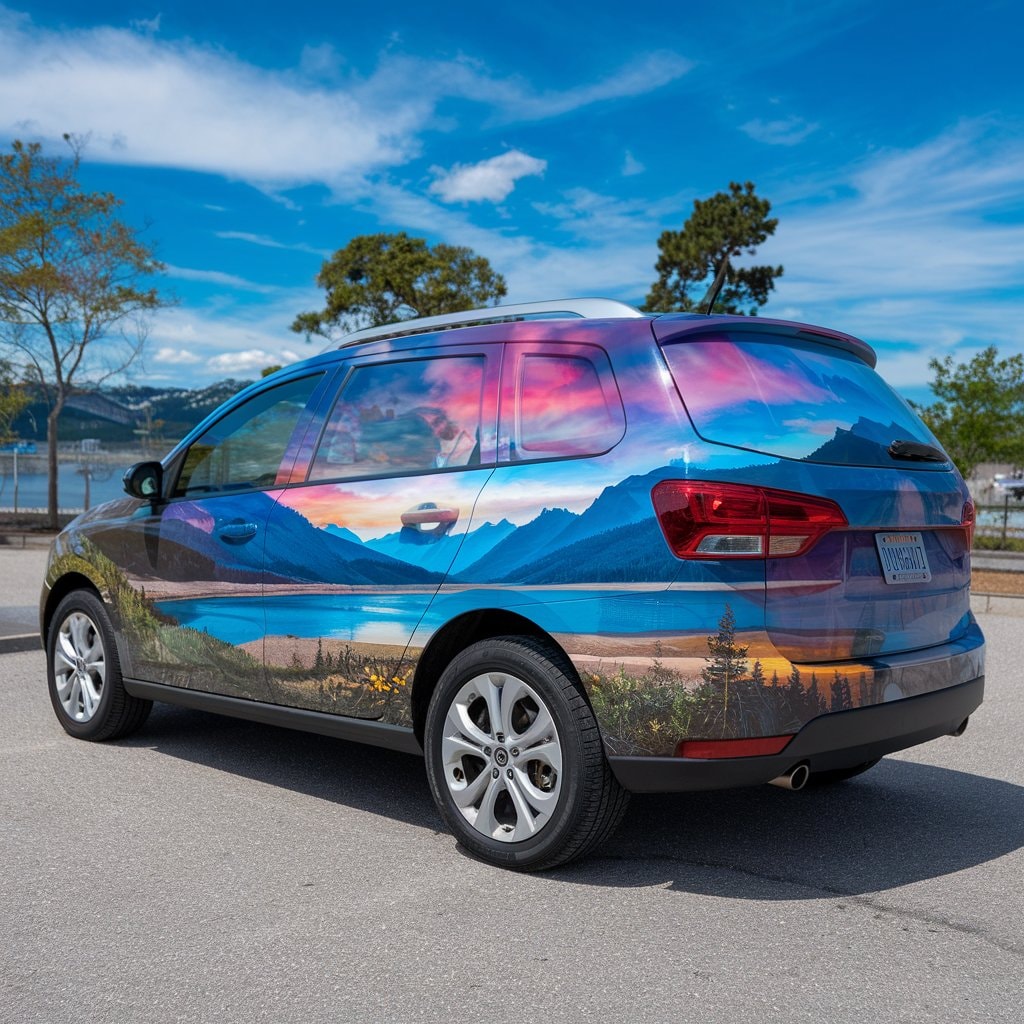
Can a Vinyl Car Wrap Change the Look of Your Vehicle?
A vinyl car wrap can dramatically change the appearance of your vehicle. With various designs and colors available, owners have the freedom to customize their cars in unique ways. Whether you’re looking for a bright color, matte finish, or custom graphics, a wrap provides these options without permanent changes to your original paint.
Car enthusiasts often turn to vinyl wraps as an alternative to paint jobs for several reasons. Wraps offer paint protection treatments against scratches, abrasions, and UV rays while maintaining the car’s resale value.
They act as a shield, keeping the original color intact and free from damage that everyday use can cause. Moreover, applying a wrap is reversible; if you decide on another look or want to return to the original color, removing the vinyl coating is straightforward.
This flexibility makes it an attractive choice for personalizing your ride while ensuring it remains in top condition over time.
Conclusion
The process of car wrapping serves as a solid shield against blemishes, corrosion and detrimental UV exposure, thereby conserving the original paint and positively influencing affect the resale value potential of a vehicle.
As such, those owners who are interested in the preservation of their investment or in updating their vehicle’s aesthetic should view vinyl vehicle wraps as an adaptable and effective alternative.
A well-executed installation confirms that the wrap does not present as bubbled, thin, or subpar, guaranteeing your car maintains a sophisticated and professional look.
A skillfully applied wrap secures your car in its best condition – maintaining its value and improving its look.
The selection of an appropriate wrap for your vehicle involves recognizing the advantages and disadvantages of car wrapping and the various patterns and materials on offer. Vehicle vinyl wraps are composed of a resilient layer that defends against environmental damage while also providing the capacity for total reversibility.
This implies that, if desired, you can revert to your car’s initial shade without harming the paint below, making sure that bird droppings or severe sunlight will not deteriorate your valuable asset over time.


